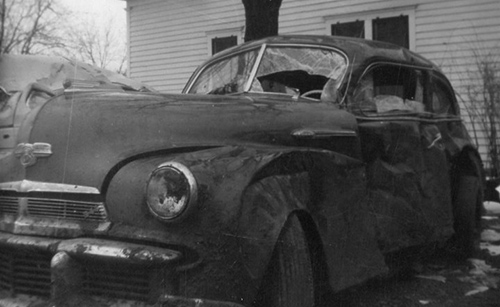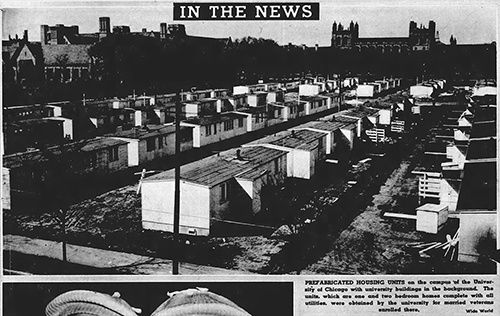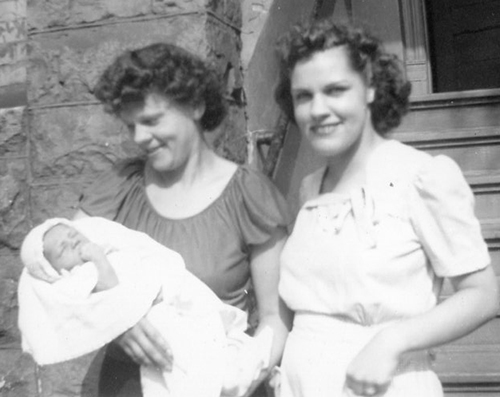Part 1 | 2 | 3 | 4 | 5 | 6 | 7 | 8 | 9 | 10 | 11 | 12 | 13 | 14 | 15 | 16 | 17 | 18 | 19 | 20 | 21 | 22 | 23 | 24 | 25
During the 1990s, a few years before my father, Dave, passed away in December of 2000, he wrote a 35-page autobiography. Excerpts from it will be published here, as companions to the diaries my mother, Dorothy, kept in 1945 and 1946—the year she met Dave. My dad was born in 1927, in Hamilton, Ohio. The family eventually moved to the south side of Chicago.
Part 22
Homeward Bound
Southern California's first blizzard in a hundred years hit us on January 10, 1949—the day we left my brother's house for the long, 2,000-mile journey back home to Chicago.
Twenty miles out from LA, we wondered whether we should turn back, but we continued eastward on Route 66, up into the mountains. As our 1940 Oldsmobile climbed the steep, snowy highway, we heard a siren from behind us. It was a California State Police car. We pulled over, and the trooper approached us.
“I'm sorry, sir, but we're not allowing any vehicles to proceed any further unless without snow chains on their tires. You'll have to turn around here.”
Even tho chains could be bought at a Sears for under ten dollars a set, our funds were low at this point. We had no choice but to return to LA to borrow the money from my brother Oregon, fighting the blizzard the entire way there.
The next morning, the snow had stopped and the roads had begun to clear. We were on our way once again, with the required chains on our tires. We could relax a little bit.
Within a few hours, our newly-purchased chains started to rattle, and in a short time, tore themselves loose on the now-dry pavement.
On our second night out, we stayed at a little motel somewhere in New Mexico. Early the next morning, Dorothy and I packed up the car and departed. Later that day, as I was taking things out for our next night's stay, I noticed an item I hadn't seen before, a pillowcase. Stuffed inside it was a familiar-looking chenille bedspread, embroidered with a Mexican figure and a cactus. “Dorothy the thief!,” I said to myself. It was the bedspread from the New Mexico motel!
With all the delays and what not, the end of my three weeks' of vacation was coming up fast, and we would have to get moving if I was going to get back to my job on time.
We got an early start on our third morning, even skipping our usual breakfast so that we'd be on the highway while the traffic was still light. Coming up over a hill, there was a flatbed semi- trailer-truck coming right towards us, in our lane, passing a vehicle in a no-passing zone. Quickly, I made a hard right to avoid a collision, but the truck hit us in our car's left front fender, flipping us and our vehicle upside-down and then right-side up again, 20-feet off the road and into a farmer's field.
To this very day, I don't know how Dorothy and I survived.

What was left of Dave and Dorothy's 1940 Oldsmobile, after the accident
It must have been my quick turn to the right that saved us, resulting, fortunately, in only a glancing blow to our Oldsmobile. Luckily, we were both OK. I was unscathed; Doroth had a small cut on her leg, and a bruise or two. The trucker's insurance agent came to the scene of the accident, had our car towed, handled the police reports and paid for our train tickets. We had recently learned that we were going to be parents, and that may have influenced the treatment we received. All in all, even tho our car was a total loss, Dorothy and I escaped a worse fate.
We were back in Chicago, back home at last. Expectant parents, living with Dorothy's mom and dad. Of course, our intent was to find a better place, and we did. The US government was offering low-cost housing to WWII GIs like me, and one of these developments was on the southwest side of Chicago, not far from what had been a wartime factory.** These were mostly plywood, temporary structures, but after our unpleasant experience living above a noisy tavern, it sounded great to us.

Postwar housing, of the type that Dorothy and Dave had moved to in 1949
The unit we were renting was part of a long building which had been sectioned-off with wallboard into trailer-sized spaces. The front portion of our space was an “all-purpose” room. In the rear area was a small kitchen and shower/bath combination. The walls were so thin that you could hear the neighbors breathing.
I was working hard at my job, in order to get ahead, and despite the shabbiness of our new home, Dorothy and I drew much closer. In August, and with the a little help from Dr. Coopersmith, our son, David, was born at Englewood Hospital, only a few blocks from Dorothy's parents. Back at home, our baby slept in a little crib I'd bought, while Dorth and I slept on a pullout couch. We realized that the three of us were bound together, truly a family.

Dorothy, at right, with her mother, Pauline, and the newly-arrived David
* * *
End of Part 22
** This wartime factory would become the home of the short-lived Tucker automobile, and later the site of the Ford City shopping center.
Part 1 | 2 | 3 | 4 | 5 | 6 | 7 | 8 | 9 | 10 | 11 | 12 | 13 | 14 | 15 | 16 | 17 | 18 | 19 | 20 | 21 | 22 | 23 | 24 | 25
|

